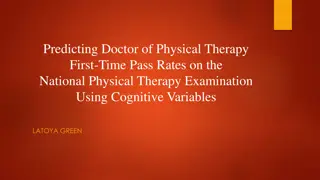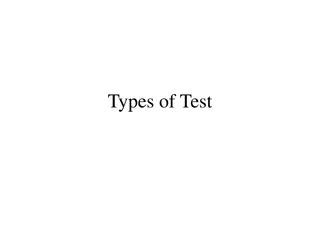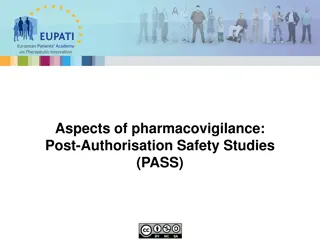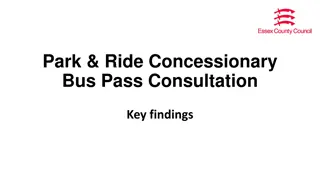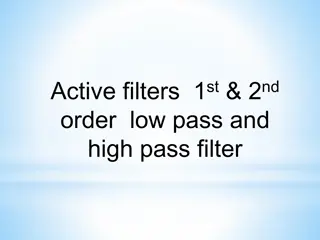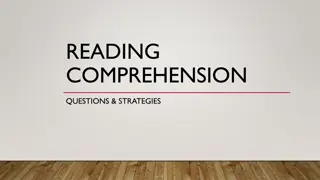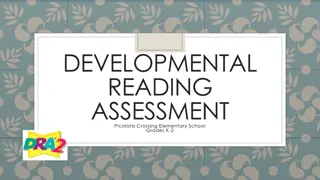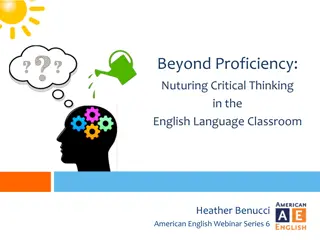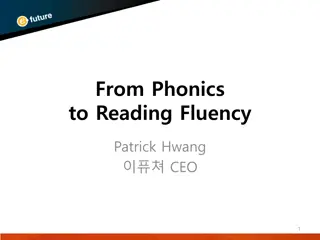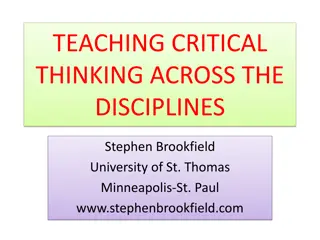Predicting NPTE First Time Pass Rates with Reading Comprehension and Critical Thinking Tests
This study by Latoya Green aims to determine if the Nelson Denny Reading Test (NDRT) and Health Sciences Reasoning Test (HSRT) can predict first time pass rates on the National Physical Therapy Examination (NPTE) for physical therapy and physical therapist assistant programs. The NDRT assesses reading ability through vocabulary and comprehension sections, while the HSRT focuses on critical thinking skills in a health care context. The research seeks to address the increasing demand for predicting NPTE success in higher education.
Download Presentation

Please find below an Image/Link to download the presentation.
The content on the website is provided AS IS for your information and personal use only. It may not be sold, licensed, or shared on other websites without obtaining consent from the author. Download presentation by click this link. If you encounter any issues during the download, it is possible that the publisher has removed the file from their server.
E N D
Presentation Transcript
The Prediction of National Physical Therapy Examination First Time Pass Rates Using Reading Comprehension and Critical Thinking Skills Tests LATOYA GREEN
Relevance to Higher Education Increasing mean average enrollment rates in physical therapy (PT) and physical therapist assistant (PTA) programs. Increasing demand to predict first time pass rates on the National Physical Therapy Examination (NPTE). Need more research on the combined use of reading comprehension and critical thinking skills for assessing physical therapy and physical therapist assistant students.
Purpose of Study Will the Nelson Denny Reading Test (NDRT) and Health Sciences Reasoning Test (HSRT) predict first time pass rates on the NPTE in physical therapy and physical therapist assistant programs at Arkansas State University?
Nelson Denny Reading Test (NDRT) a standardized reading test that measures the reading ability of high school and college students. consists of vocabulary and comprehension sections. vocabulary portion has 80 multiple choice questions with five possible answer choices.
Nelson Denny Reading Test (NDRT) Fifteen minutes are allowed for the completion of this portion of the exam. The comprehension portion consists of five to eight passages from which students must answer three multiple choice questions based on content of those passages. Students are given 20 minutes to complete this portion of the exam.
Health Sciences Reasoning Test (HSRT) a critical thinking test written specifically for health care. Questions are set within a health care context. The test is a multiple-choice test that is administered with 45 to 50 minutes. The test contains five subscale critical thinking areas: analysis and interpretation, inference, evaluation and explanation, deductive reasoning, and inductive reasoning.
Methodology Physical Therapy students
Methodology Physical Therapy Assistant students
Methodology The study will conclude after each physical therapy and physical therapist assistant student has completed his/her respective board exam. The anticipated conclusion date for this study is February 2021.
Results For the DPT class of 2017, cumulative GPA was the only predictor variable that was significant (p = .019) with the NPTE. Cumulative GPA was also more highly correlated with the NPTE (r = .579) than the other two predictor variables. The combination of HSRT, NDRT and GPA variables could not predict first time attempt success on the NPTE any better than GPA alone.
Results For the PTA class of 2017, cumulative GPA (p = .001) was significant with the NPTE. Cumulative GPA (r = .612) showed a stronger relationship with the NPTE than the HSRT (r = .408) and NDRT (r = .252). Thirty-eight percent of the variance in the NPTE could be accounted for by the combined predictor variables. Cumulative GPA was the strongest predictor.
Results Figure 1. GPA and NPTE relationship for PTA students
Summary and Conclusion The DPT class of 2017 had a 100% first time pass rate on the NPTE; however, the results of this study did not identify any model/combination of variables that could predict NPTE scores any better than GPA. In contrast, the NDRT, HSRT, and GPA could moderately well predict first time pass rates on the NPTE for the PTA class of 2017. In conclusion, students who perform well, in terms of academic performance, in either the DPT or PTA curricula have a higher likelihood of passing the NPTE on the first attempt. Additionally, the NDRT and the HSRT may be useful predictor variables for PTA students challenging the NPTE.
Anticipated Benefits If a correlation exists between the NDRT, HSRT, and the NPTE, then early intervention can be provided for at risk students. The subjects could gain insight to their reading level and critical thinking ability; hence, gaining insight will allow subjects to seek guidance to improve their reading and critical thinking skills. Society could benefit from this research if the NDRT and HSRT can predict first time pass rates on board exams; implementing these tests prior to a student s matriculation through either the PT or PTA program could lead to early intervention and an increased likelihood of first time pass rates.


